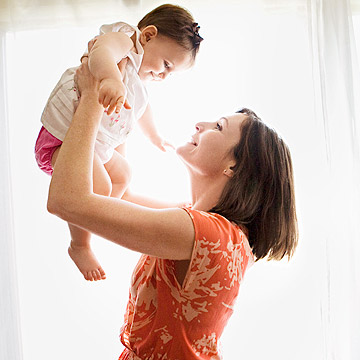
Handle With Care
Back when my son, Luca, was a baby, I'd tote him around on my hip while I tackled cooking, cleaning, and load after load of dirty laundry. Then one day, as I stooped to grab a toy, my back seized up. I spent the next three days recovering in bed.
For all its luminous rewards, motherhood can be hard on the body. What may start out as minor aches and pains can escalate into full-blown repetitive strain injuries. The moves moms make every day, such as hoisting baby from a crib and hunching over to breastfeed, can cause chronic irritation to the muscles, tendons or joints, according to Jill Boissonnault, Ph.D., a professor of physical therapy at the University of Wisconsin in Madison.
Physical changes due to pregnancy and delivery are part of the equation. Changes in maternal hormones loosen the tissue around joints, allowing the pelvis to widen to accommodate the baby before and during birth. The slackness remains for months after delivery, leaving joints vulnerable to strain. Pregnancy and delivery also take their toll on the abdominal and pelvic muscles, and the baby's weight pulls your center of gravity forward, often leading to a swayed back.
Repetitive strain injuries affect more than just your body: Studies have shown that untreated pain can actually make women more susceptible to postpartum depression. "These injuries can harm a woman's quality of life," says Dr. Boissonnault. "For their mental and physical health, moms need to seek treatment."
No need to stockpile pain meds and ice packs. Get the 411 on common new-mom aches, ways to avoid them, and how to feel better if you're already hurting.
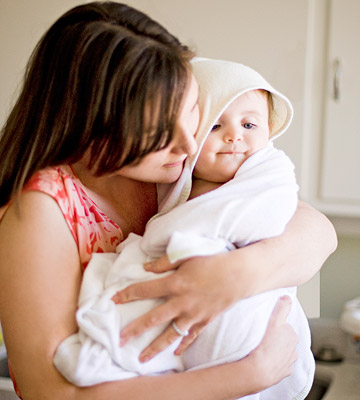
Mommy Mistake: Holding Baby With a Bent Wrist
The injury De Quervain's tenosynovitis, aka "mother's wrist." The area is often tender, and making a fist or rotating the wrist is painful. This occurs when the sheath around the tendons at the base of the wrist and thumb becomes swollen, due to overextension or flexing too much. Fluid retention and hormonal changes during pregnancy also cause the tissues around the tendons to swell and become inflamed.
Prevent it Hold your baby in a way that doesn't overexert the muscles of your hand, wrist, and forearm, says Deborah Quilter, a movement therapist in New York City and author of The Repetitive Strain Injury Recovery Book. Keep your forearm, wrist, and hand in a straight line instead of bending the wrist to hold your baby's head. Take frequent breaks from any hand-intensive activity, and allow your hand and wrist to rest in a neutral position. If possible, carry your child with both arms or use a baby carrier. And when pushing a stroller, place your palms on top of the handles to minimize the tendency to bend your wrists.
Heal it Don't take a wait-and-see approach to wrist pain. "If you ignore this problem in one hand, you run the risk of overusing the other, and then both hands will be affected," says Robert E. Markison, M.D., a hand surgeon and associate clinical professor at the University of California, San Francisco. See an orthopedist who may recommend a wrist splint to stabilize the hand and thumb. You can relieve some inflammation by gently massaging the wrist, moving your strokes toward your elbow. Also, alternate warm and cool hand and wrist baths. If nothing helps, your doctor might use a cortisone injection to reduce inflammation. More severe cases may require surgery to open up part of the tendon's sheath to release the pressure that's causing the pain.
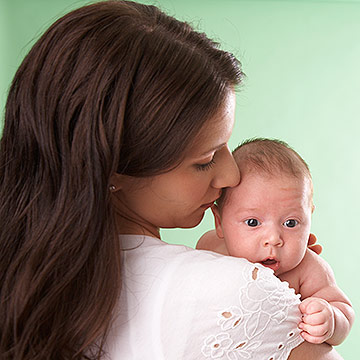
Mommy Mistake: Picking Up or Carrying Baby in Awkward Positions
The injury A "thrown-out" or strained back. A back injury often appears to be the consequence of a single wrong move, but it's more often due to months or even years of poor posture and weak core muscles. When you suddenly begin exerting your back in different ways as you care for a baby, the disk between the vertebrae, as well as the muscles and ligaments in the region, can all suffer strain.
Prevent it Whenever you're hoisting baby off the floor — or picking up her toys, for that matter — bend at your knees. Hold her close to your belly button as you stand up, and avoid twisting your torso while lifting, which places the spinal area at risk for injury. One of the riskiest moves? Getting baby in and out of the car, Dr. Boissonault says. Lock in the car seat first, without the added weight of the baby. Then sit down next to the seat and turn to face it before buckling her in. If the car seat is next to the door and you can't sit, bend slightly at the knees and lower into a shallow squat while you fasten the straps; this way, you'll be less likely to hunch your back.
Heal it The most important remedy for a strained back is rest, which means lifting your baby as infrequently as possible, says George Piligian, M.D., an occupational medicine specialist at Mt. Sinai Medical Center's Selikoff Clinic, in New York City. The muscles need time to heal, which may take from a few days to a week or more. Heating pads can provide some immediate relief, although you might find ice packs helpful too. (Ice tamps down inflammation, and heat can help loosen up stiff tissues.) If you feel pain radiating down your legs, see a doctor — you may have a herniated disk. Ask your doctor about a set of strengthening exercises to do at home.
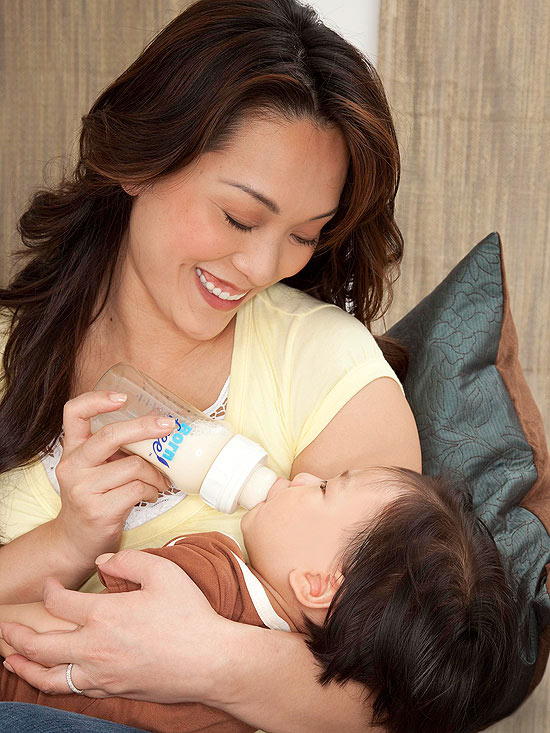
Mommy Mistake: Hunching Over During Feedings
The injury Pulled or strained neck and shoulder muscles. Spending hours with your neck pushed forward means the shoulder and neck muscles have to work harder to support your head, which can lead to overstretching or small tears. "This is one of the most common postpartum complaints because mothers spend so much time seated, leaning forward, and gazing down at the baby during feeding sessions," advises Heather Jeffcoat, a physical therapist in Los Angeles.
Prevent it While feeding your baby, be sure to look up periodically and do rolling-neck stretches, recommends Wendy Haldeman, R.N., a lactation consultant in Los Angeles. Use a footstool and a pillow or a nursing pillow to raise your baby a bit higher. Keep your arms free, resting on the pillow, so they aren't bearing your baby's weight. If you're bottle-feeding, switch sides regularly to give your arms and shoulders a rest.
Heal it To counteract the frequent overstretching of the muscles around the spine and neck, you need to do exercises that isolate and stretch the muscles in front, says Dr. Piligian. One easy move: Clasp your hands behind your waist and gently extend your arms further back to open up the chest area. Applying heating pads can improve circulation and loosen tight muscles. A deep-tissue massage can provide relief. If the problem persists, see a doctor. You could have tendinitis, which may require treatment with anti-inflammatory medication.
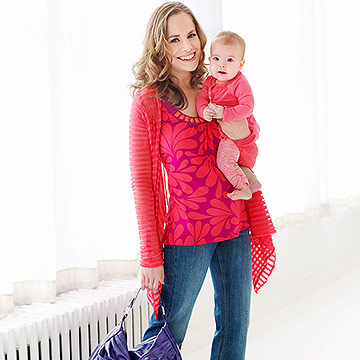
Mommy Mistake: Balancing Your Baby on a Cocked Hip
The injury Pelvic girdle pain. There are actually a range of potential postpartum pelvic problems and nearly all begin with misalignment of the back, pelvis, or tailbone.
Prevent it Avoid holding your baby on one hip, supporting her with just one arm and tilting your pelvis in the process. Instead, hold her with both arms, close to your body. When you do use the hip carry, switch sides regularly. Maintaining correct posture can help prevent pelvic pain. Try to avoid slumping in a chair or standing with your pelvis thrust forward in swayback fashion, advises Amy Stein, a physical therapist in New York City and author of Heal Pelvic Pain. Change position often to maintain good blood flow to the area. To keep your pelvis from tilting too far back and putting pressure on your tailbone while sitting, use a cushion to support your lower back. If you're breastfeeding, alternate between sitting and lying down.
Heal it "Seek out a doctor who's knowledgeable about pelvic pain," says Deborah Coady, M.D., an assistant professor of obstetrics and gynecology at New York University's Langone Medical Center. Treatment may include targeted exercises and massage. Good circulation is crucial to the repair process, so heating pads and warm baths that promote blood flow can be helpful for pain relief and long-term healing.
Originally published in the April 2011 issue of American Baby magazine.
All content on this Web site, including medical opinion and any other health-related information, is for informational purposes only and should not be considered to be a specific diagnosis or treatment plan for any individual situation. Use of this site and the information contained herein does not create a doctor-patient relationship. Always seek the direct advice of your own doctor in connection with any questions or issues you may have regarding your own health or the health of others.
American Baby
